HC Verma Physics books are the most preferred books among students of CBSE schools. Students can be found referring to the chapters as well as practice questions at the end of each of these chapters, in the books. Students follow these textbooks religiously since quite a few questions in these also appear in exams.
Contents
- 1 HC Verma Solutions for Class 11 Physics 7 – Circular Motion
- 1.0.1 Page No 111:
- 1.0.2 Question 1:
- 1.0.3 Answer:
- 1.0.4 Page No 112:
- 1.0.5 Question 2:
- 1.0.6 Answer:
- 1.0.7 Question 3:
- 1.0.8 Answer:
- 1.0.9 Question 4:
- 1.0.10 Answer:
- 1.0.11 Question 5:
- 1.0.12 Answer:
- 1.0.13 Question 6:
- 1.0.14 Answer:
- 1.0.15 Question 7:
- 1.0.16 Answer:
- 1.0.17 Question 8:
- 1.0.18 Answer:
- 1.0.19 Question 9:
- 1.0.20 Answer:
- 1.0.21 Question 10:
- 1.0.22 Answer:
- 1.0.23 Question 1:
- 1.0.24 Answer:
- 1.0.25 Question 2:
- 1.0.26 Answer:
- 1.0.27 Question 3:
- 1.0.28 Answer:
- 1.0.29 Question 4:
- 1.0.30 Answer:
- 1.0.31 Question 5:
- 1.0.32 Answer:
- 1.0.33 Question 6:
- 1.0.34 Answer:
- 1.0.35 Question 7:
- 1.0.36 Answer:
- 1.0.37 Page No 113:
- 1.0.38 Question 8:
- 1.0.39 Answer:
- 1.0.40 Question 9:
- 1.0.41 Answer:
- 1.0.42 Question 10:
- 1.0.43 Answer:
- 1.0.44 Question 11:
- 1.0.45 Answer:
- 1.0.46 Question 12:
- 1.0.47 Answer:
- 1.0.48 Question 13:
- 1.0.49 Answer:
- 1.0.50 Question 14:
- 1.0.51 Answer:
- 1.0.52 Question 15:
- 1.0.53 Answer:
- 1.0.54 Question 16:
- 1.0.55 Answer:
- 1.0.56 Question 1:
- 1.0.57 Answer:
- 1.0.58 Question 2:
- 1.0.59 Answer:
- 1.0.60 Question 3:
- 1.0.61 Answer:
- 1.0.62 Question 4:
- 1.0.63 Answer:
- 1.0.64 Page No 114:
- 1.0.65 Question 5:
- 1.0.66 Answer:
- 1.0.67 Question 6:
- 1.0.68 Answer:
- 1.0.69 Question 7:
- 1.0.70 Answer:
- 1.0.71 Question 1:
- 1.0.72 Answer:
- 1.0.73 Question 2:
- 1.0.74 Answer:
- 1.0.75 Question 3:
- 1.0.76 Answer:
- 1.0.77 Question 4:
- 1.0.78 Answer:
- 1.0.79 Question 5:
- 1.0.80 Answer:
- 1.0.81 Question 6:
- 1.0.82 Answer:
- 1.0.83 Question 7:
- 1.0.84 Answer:
- 1.0.85 Question 8:
- 1.0.86 Answer:
- 1.0.87 Question 9:
- 1.0.88 Answer:
- 1.0.89 Question 10:
- 1.0.90 Answer:
- 1.0.91 Question 11:
- 1.0.92 Answer:
- 1.0.93 Question 12:
- 1.0.94 Answer:
- 1.0.95 Question 13:
- 1.0.96 Answer:
- 1.0.97 Page No 115:
- 1.0.98 Question 14:
- 1.0.99 Answer:
- 1.0.100 Question 15:
- 1.0.101 Answer:
- 1.0.102 Question 16:
- 1.0.103 Answer:
- 1.0.104 Question 17:
- 1.0.105 Answer:
- 1.0.106 Question 18:
- 1.0.107 Answer:
- 1.0.108 Question 19:
- 1.0.109 Answer:
- 1.0.110 Question 20:
- 1.0.111 Answer:
- 1.0.112 Question 21:
- 1.0.113 Answer:
- 1.0.114 Question 22:
- 1.0.115 Answer:
- 1.0.116 Question 23:
- 1.0.117 Answer:
- 1.0.118 Question 24:
- 1.0.119 Answer:
- 1.0.120 Question 25:
- 1.0.121 Answer:
- 1.0.122 Question 26:
- 1.0.123 Answer:
- 1.0.124 Question 27:
- 1.0.125 Answer:
- 1.0.126 Page No 116:
- 1.0.127 Question 28:
- 1.0.128 Answer:
- 1.0.129 Question 29:
- 1.0.130 Answer:
- 1.0.131 Question 30:
- 1.0.132 Answer:
- 2 Chapterwise HC Verma Solutions Class 11 Physics :
- 3 About the Author – HC Verma
HC Verma Solutions for Class 11 Physics 7 – Circular Motion
For such popular books, students can get extremely helpful practice material online. For all the questions in the HC Verma books, there are several sources where students can get detailed solutions and solve their doubts and queries.
Please note that these solutions are provided here for free.
Page No 111:
Question 1:
You are driving a motorcycle on a horizontal road. It is moving with a uniform velocity. Is it possible to accelerate the motorcycle without putting higher petrol input rate into the engine?
Answer:
Yes, it is possible to accelerate the motorcycle without putting higher petrol input rate into the engine by driving the motorcycle on a circular track.
Page No 112:
Question 2:
Some washing machines have cloth driers. It contains a drum in which wet clothes are kept. As the drum rotates, the water particles get separated from the cloth. The general description of this action is that “the centrifugal force throws the water particles away from the drum”. Comment on this statement from the viewpoint of an observer rotating with the drum and the observer who is washing the clothes.
Answer:
The person rotating with the drum will observe that centrifugal force and coriolis force act on the water particles and the person washing the cloth will observe that water particles are thrown outward (away from the drum) and no pseudo force is acting on the particles.
Question 3:
A small coin is placed on a record rotating at
3313rev/minute. The coin does not slip on the record. Where does it get the required centripetal force from?
Answer:
The coin gets the required centripetal force from the frictional force between the coin and the record.
Question 4:
A bird while flying takes a left turn, where does it get the centripetal force from?
Answer:
The bird tilts its body and tail in such a way that the air around offers a dragging force in left direction, perpendicular to its initial direction of motion. This dragging force provides the necessary centripetal force to take the left turn.
Question 5:
Is it necessary to express all angles in radian while using the equation ω = ω0 + at?
Answer:
No, it is not necessary to express all the angles in radian while using the equation ω = ω0 + at.
If ω (angular velocity) and α (angular acceleration) are in rad/s and rad/s2, respectively, we will get the angle in radian.
Question 6:
After a good meal at a party you wash your hands and find that you have forgotten to bring your handkerchief. You shake your hand vigorously to remove the water as much as you can. Why is water removed in this process?
Answer:
While shaking, our hand moves on a curved path with some angular velocity and water on our hand feels centrifugal force in the outward direction. Therefore, water get detached from our hand and leaves it.
Question 7:
A smooth block loosely fits in a circular tube placed on a horizontal surface. The block moves in a uniform circular motion along the tube. Which wall (inner or outer) will exert a nonzero normal contact force on the block?
Figure
Answer:
The outer wall will exert a non-zero normal contact force on the block. As the block moves in a uniform circular motion, centrifugal force in radially outward direction acts on it and it comes in contact with the outer wall of the tube.
Question 8:
Consider the circular motion of the earth around the sun. Which of the following statements is more appropriate?
(a) Gravitational attraction of the sun on the earth is equal to the centripetal force.
(b) Gravitational attraction of the sun on the earth is the centripetal force.
Answer:
(a) Gravitational attraction of the Sun on the Earth is equal to the centripetal force. This statement is more appropriate.
Gravitational attraction of the Sun on the Earth provides the necessary centripetal force required for the circular motion of the Earth around the Sun.
Question 9:
A car driver going at some speed v suddenly finds a wide wall at a distance r. Should he apply brakes or turn the car in a circle of radius r to avoid hitting the wall?
Answer:
As the wall is at a distance r, the driver should either take a circular turn of radius r or apply brakes to avoid hitting the wall.
Question 10:
A heavy mass m is hanging from a string in equilibrium without breaking it. When this same mass is set into oscillation, the string breaks. Explain.
Answer:
When the same mass is set into oscillation, the tension in the string increases because of the additional centripetal force of the mass oscillating in a curved path.
Question 1:
When a particle moves in a circle with a uniform speed
(a) its velocity and acceleration are both constant
(b) its velocity is constant but the acceleration changes
(c) its acceleration is constant but the velocity changes
(d) its velocity and acceleration both change.
Answer:
(d) its velocity and acceleration both change.
In a circular motion, the direction of particle changes. Therefore, velocity, being a vector quantity, also changes.
As the velocity changes, acceleration also changes.
Question 2:
Tow cars having masses m1 and m2 moves in circles of radii r1 and r2 respectively. If they complete the circle in equal time, the ratio of their angular speed ω1/ω2 is
(a) m1/m2
(b) r1/r2
(c) m1r1/m2/r2
(d) 1.
Answer:
(d) 1
Time period (T) is same for both the cars.
We know that:
ω∝1TSo, ω1ω2=1
Question 3:
A car moves at a constant speed on a road as shown in figure. The normal force by the road on the car NA and NB when it is at the points A and B respectively.
(a) NA = NB
(b) NA > NB
(c) NA < NB
(d) insufficient
Figure
Answer:
(c) NA < NB
From the figure in the question, it is clear that
rB>rA.
Here, normal reaction is inversely proportional to the centrifugal force acting on the car, while taking turn on the curve track. Also, centrifugal force is inversely proportional to the radius of the circular track.
Therefore, we have:
NA < NB
Question 4:
A particle of mass m is observed from an inertial frame of reference and is found to move in a circle of radius r with a uniform speed v. The centrifugal force on it is
(a)
mv2rtowards the centre
(b)
mv2raway from the centre
(c)
mv2ralong the tangent through the particle
(d) zero
Answer:
(d) zero
The centrifugal force is a pseudo force and can only be observed from the frame of reference, which is non-inertial w.r.t. the particle.
Question 5:
A particle of mass m rotates with a uniform angular speed ω. It is viewed from a frame rotating about the Z-axis with a uniform angular speed ω0. The centrifugal force on the particle is
(a) mω2a
(b)
mω02a(c)
mω+ω022a(d) mω ω0 a.
Answer:
(b)
mω02aThe centrifugal force on the particle depends on the angular speed (ω0) of the frame and not on the angular speed (ω) of the particle. Thus, the value of centrifugal force on the particle is
mω02a.
Question 6:
A particle is kept fixed on a turntable rotating uniformly. As seen from the ground the particle goes in a circle, its speed is 20 cm/s and acceleration is 20 cm/s2. The particle is now shifted to a new position to make the radius half of the original value. The new value of the speed and acceleration will be
(a) 10 cm/s, 10 cm/s2
(b) 10 cm/s, 80 cm/s2
(c) 40 cm/s, 10 cm/s2
(d) 40 cm/s, 40 cm/s2
Answer:
(a) 10 cm/s, 10 cm/s2
It is given that the turntable is rotating with uniform angular velocity. Let the velocity be
ω.
We have:
v=rω⇒v∝r (for constant ω)vv’=rr’⇒v’=v2=10 cm/sSimilarly, we have:
a’=a2=10 cm/s2
Question 7:
Water in a bucket is whirled in a vertical circle with string attached to it. The water does no fall down even when the bucket is inverted at the top of its path. We conclude that in this position
(a)
mg=mv2r(b) mg is greater than
mv2r(c) mg is not greater than
mv2r(d) mg is not less than
mv2r.
Answer:
(c) mg is not greater than
mv2rAt the top of the path, the direction of mg is vertically downward and for centrifugal force
mv2r, the direction is vertically upward. If the vertically downward force is not greater, water will not fall.
Page No 113:
Question 8:
A stone of mass m tied to a string of length l is rotated in a circle with the other end of the string as the centre. The speed of the stone is v. If the string breaks, the stone will move
(a) towards the centre
(b) away from the centre
(c) along a tangent
(d) will stop.
Answer:
(c) along a tangent
The stone will move in a circle and the direction of velocity at any instant is always along the tangent at that point. Therefore, the stone will move along the tangent to the circle at a point where the string breaks.
Question 9:
A coin placed on a rotating turntable just slips. If it is placed at a distance of 4 cm from the centre. If the angular velocity of the turntable is doubled, it will just slip at a distance of
(a) 1 cm
(b) 2 cm
(c) 4 cm
(d) 8 cm
Answer:
(a) 1 cm
Let the force of friction between the coin and the rotating turntable be F.
For the coin to just slip, we have:
F=mω2rHere,
mω2ris the centrifugal force acting on the coin.
For constant F and m, we have:
r∝1ω2Therefore,
r’r=ωω’2⇒r’=1 cm
Question 10:
A motorcycle is going on an overbridge of radius R. The driver maintains a constant speed. As the motorcycle is ascending on the overbridge, the normal force on it
(a) increases
(b) decreases
(c) remains the same
(d) fluctuates.
Answer:
(a) increases
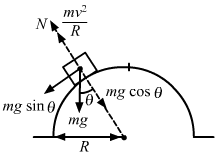
The normal force on the motorcycle,
N=mgcosθ-mv2RAs the motorcycle is ascending on the overbridge, θ decreases (from
π2to 0).
So, normal force increases with decrease in θ.
Question 11:
Three identical cars A, B and C are moving at the same speed on three bridges. The car A goes on a place bridge, B on a bridge convex upward and C goes on a bridge concave upward. Let FA, FB and FC be the normal forces exerted by the car on the bridges when they are at the middle of bridges.
(a) FA is maximum of the three forces.
(b) FB is maximum of the three forces.
(c) FC is maximum of the three forces.
(d) FA = FB = FC.
Answer:
(c) FC is maximum of the three forces.
At the middle of bridge, normal force can be given as:
NA=mg
NB=mv2r-mgNC=mv2r+mgSo, FC is maximum.

Question 12:
A train A runs from east to west and another train B of the same mass runs from west to east at the same speed along the equator. A presses the track with a force F1 and B presses the track with a force F2.
(a) F1 > F2.
(b) F1 < F2
(c) F1 = F2
(d) the information is insufficient to find the relation between F1 and F2.
Answer:
(a) F1 > F2
When the trains are moving, effective angular velocity of both the trains are different (as shown in the figure).
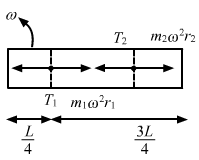
Effective angular velocity of train B is more than that of train A.
Normal force with which both the trains push the tracks is given as:
N=mg-mRω’2From the above equation, we can conclude that F1 > F2.
Question 13:
If the earth stop rotating, the apparent value of g on its surface will
(a) increase everywhere
(b) decrease everywhere
(c) remain the same everywhere
(d) increase at some places and remain the same at some other places.
Answer:
(d) increase at some places and remain the same at some other places
If the Earth stops rotating on its axis, there will be an increase in the value of acceleration due to gravity at the equator. At the same time, there will be no change in the value of g at the poles.
Question 14:
A rod of length L is pivoted at one end and is rotated with a uniform angular velocity in a horizontal plane. Let T1 and T2 be the tensions at the points L/4 and 3L/4 away from the pivoted ends.
(a) T1 > T2
(b) T2 > T1
(c) T1 = T2
(d) The relation between T1 and T2 depends on whether the rod rotates clockwise or anticlockwise.
Answer:
(a) T1 > T2

Let the angular velocity of the rod be
ω.
Distance of the centre of mass of portion of the rod on the right side of L/4 from the pivoted end:
r1=L4+123L4=5L8Mass of the rod on the right side of L/4 from the pivoted end:
m1=34MAt point L/4, we have:
T1=m1ω2r1 =34Mω258L=1532Mω2LDistance of the centre of mass of rod on the right side of 3L/4 from the pivoted end:
r1=12L4+3L4=7L8Mass of the rod on the right side of L/4 from the pivoted end:
m1=14MAt point 3L/4, we have:
T2=m2ω2r2 =14Mω278L=732Mω2L∴ T1 > T2
Question 15:
A simple pendulum having a bob of mass m is suspended from the ceiling of a car used in a stunt film shooting. the car moves up along an inclined cliff at a speed v and makes a jump to leave the cliff and lands at some distance. Let R be the maximum height of the car from the top of the cliff. The tension in the string when the car is in air is
(a) mg
(b)
mg-mv2R(c)
mg+mv2R(d) zero.
Answer:
(d) zero
When the car is in air, the acceleration of bob and car is same. Hence, the tension in the string will be zero.
Question 16:
Let θ denote the angular displacement of a simple pendulum oscillating in a vertical plane. If the mass of the bob is m, the tension is the string is mg cos θ
(a) always
(b) never
(c) at the extreme positions
(d) at the mean position.
Answer:
(c) at the extreme positions
Tension is the string,
T=mv2r-mgcosθWhen v = 0,
T=mgcosθThat is, at the extreme positions, the tension is the string is mgcosθ.
Question 1:
An object follows a curved path. The following quantities may remain constant during the motion
(a) speed
(b) velocity
(c) acceleration
(d) magnitude of acceleration.
Answer:
(a) speed
(d) magnitude of acceleration
When an object follows a curved path, its direction changes continuously. So, the scalar quantities like speed and magnitude of acceleration may remain constant during the motion.
Question 2:
Assume that the earth goes round the sun in a circular orbit with a constant speed of 30 kms
(a) The average velocity of the earth from 1st jan, 90 to 30th June, 90 is zero.
(b) The average acceleration during the above period is 60 km/s2.
(c) The average speed from 1st Jan, 90 to 31st Dec, 90 is zero.
(d) The instantaneous acceleration of the earth points towards the sun.
Answer:
(d) The instantaneous acceleration of the Earth points towards the Sun.
The speed is constant; therefore, there is no tangential acceleration and the direction of radial acceleration is towards the Sun. So, the instantaneous acceleration of the Earth points towards the Sun.
Question 3:
The position vector of a particle in a circular motion about the origin sweeps out equal area in equal time. Its
(a) velocity remains constant
(b) speed remains constant
(c) acceleration remains constant
(d) tangential acceleration remains constant.
Answer:
(b) speed remains constant
(d) tangential acceleration remains constant
If the speed is constant, the position vector of the particle sweeps out equal area in equal time in circular motion.
Also, for constant speed, tangential acceleration is zero, i.e., constant.
Question 4:
A particle is going in a spiral path as shown in figure with constant speed.
Figure
(a) The velocity of the particle is constant.
(b) The acceleration of the particle is constant.
(c) The magnitude of acceleration is constant.
(d) The magnitude of acceleration is decreasing continuously.
Answer:
(c) The magnitude of acceleration is constant.
As the pitch and radius of the path is constant, it shows that the magnitude of tangential and radial acceleration is also constant.
Hence, the magnitude of total acceleration is constant.
Page No 114:
Question 5:
A car of mass M is moving on a horizontal circular path of radius r. At an instant its speed is v and is increasing at a rate a.
(a) The acceleration of the car is towards the centre of the path.
(b) The magnitude of the frictional force on the car is greater than
mv2r.
(c) The friction coefficient between the ground and the car is not less than a/g.
(d) The friction coefficient between the ground and the car is
μ=tan-1v2rg.
Answer:
(b) The magnitude of the frictional force on the car is greater than
mv2r.
(c) The friction coefficient between the ground and the car is not less than a/g.
If the magnitude of the frictional force on the car is not greater than
mv2r, it will not move forward, as its speed (v) is increasing at a rate a.
Question 6:
A circular road of radius r is banked for a speed v = 40 km/hr. A car of mass of m attempts to go on the circular road. The friction coefficient between the tyre and the road is negligible.
(a) The are cannot make a turn without skidding.
(b) If the car turns at a speed less than 40 km/hr, it will slip down.
(c) If the car turns at the car is equal to
mv2r.
(d) If the car turns at the correct speed of 40 km/hr, the force by the road on the car is greater than mg as well as greater than
mv2r.
Answer:
(b) If the car turns at a speed less than 40 km/hr, it will slip down.
(d) If the car turns at the correct speed of 40 km/hr, the force by the road on the car is greater than mg as well as greater than
mv2r.
The friction is zero and the road is banked for a speed v = 40 km/hr. If the car turns at a speed less than 40 km/hr, it will slip down.
Question 7:
A person applies constant force
F→on a particle of mass m and finds that the particle moves in a circle of radius r with a uniform speed v as seen from an inertial frame of reference.
(a) This is not possible.
(b) There are other forces on the particle.
(c) The resultant of the other forces is
mv2rtowards the centre.
(d) The resultant of the other forces varies in magnitude as well as in direction
Answer:
(b) There are other forces on the particle.
(d) The resultant of the other forces varies in magnitude as well as in direction.
We cannot move a particle in a circle by just applying a constant force. So, there are other forces on the particle.
As a constant force cannot move a particle in a circle, the resultant of other forces varies in magnitude as well as in direction (because
F→is constant).
Question 1:
Find the acceleration of the moon with respect to the earth from the following data : Distance between the earth and the moon = 3.85 × 105 km and the time taken by the moon to complete one revolution around the earth = 27.3 days.
Answer:
Distance between the Earth and the Moon:
r=3.85×105 km=3.85×108 m
Time taken by the Moon to revolve around the Earth:
T=27.3 days =24×3600×27.3 s=2.36×106 sVelocity of the Moon:v=2πrT =2×3.14×3.85×1082.36×106=1025.42 m/sAcceleration of the Moon: a=v2r=(1025.42)22.36×106=0.00273 m/s2
⇒a=2.73×10-3 m/s2
Question 2:
Find the acceleration of a particle placed on the surface of the earth at the equator due to earth’s rotation. The diameter of earth = 12800 km and it takes 24 hours for the earth to complete one revolution about its axis.
Answer:
Diameter of the Earth = 12800 km
So, radius of the Earth, R = 6400 km = 6.4 × 106 m
Time period of revolution of the Earth about its axis:
T=24 hr=24×3600 sv=2πrT=2×3.14×64×10624×3600
⇒v=465.185 m/s
Acceleration of the particle:a=v2R=465.185264×105=0.038 m/s2
Question 3:
A particle moves in a circle of radius 1.0 cm at a speed given by v = 2.0 t where v is cm/s and t in seconds.
(a) Find the radial acceleration of the particle at t = 1 s.
(b) Find the tangential acceleration at t = 1 s.
(c) Find the magnitude of the acceleration at t = 1 s.
Answer:
Speed is given as a function of time. Therefore, we have:
v = 2t
Radius of the circle = r = 1 cm
At time t = 2 s, we get:
(a) Radial acceleration
a=v2r=221=4 cm/s2(b) Tangential acceleration
a=dvdt =ddt2t =2 cm/s2(c) Magnitude of acceleration
a=42+22 =20 cm/s2
Question 4:
A scooter weighing 150 kg together with its rider moving at 36 km/hr is to take a turn of a radius 30 m. What horizontal force on the scooter is needed to make the turn possible?
Answer:
Given:
Mass = m = 150 kg
Speed = v = 36 km/hr = 10 m/s
Radius of turn = r = 30 m
Let the horizontal force needed to make the turn be F. We have:
F=mv2r=150×(10)230=150×10030=500 N
Question 5:
If the horizontal force needed for the turn in the previous problem is to be supplied by the normal force by the road, what should be the proper angle of banking?
Answer:
Given:
Speed of the scooter = v = 36 km/hr = 10 m/s
Radius of turn = r = 30 m
Let the angle of banking be
θ. We have:
tanθ=v2rg
⇒tanθ=10030×10=13⇒θ=tan-113
Question 6:
A park has a radius of 10 m. If a vehicle goes round it at an average speed of 18 km/hr, what should be the proper angle of banking?
Answer:
Given:
Speed of the vehicle = v = 18 km/h = 5 m/s
Radius of the park = r = 10 m
Let the angle of banking be
θ.
Thus, we have:
tanθ=v2rg
⇒θ=tan-125100⇒θ=tan-114
Question 7:
If the road of the previous problem is horizontal (no banking), what should be the minimum friction coefficient so that scooter going at 18 km/hr does not skid?
Answer:
If the road is horizontal (no banking), we have:
mv2R=fsN=mgHere, fs is the force of friction and N is the normal reaction.
If μ is the friction coefficient, we have:
Friction force = fs=μNSo, mv2R=μmgHere,
Velocity = v = 5 m/s
Radius = R = 10 m
∴2510=μg⇒ μ=25100=0.25
Question 8:
A circular road of radius 50 m has the angle of banking equal to 30°. At what speed should a vehicle go on this road so that the friction is not used?
Answer:
Given:
Angle of banking = θ = 30°
Radius = r = 50 m
Assume that the vehicle travels on this road at speed v so that the friction is not used.
We get:
tanθ=v2rg⇒tan 30°=v2rg⇒ 13=v2rg⇒v2=rg3=50×103⇒ v=5003=17 m/s
Question 9:
In the Bohr model of hydrogen atom, the electron is treated as a particle going in a circle with the centre at the proton. The proton itself is assumed to be fixed in an inertial frame. The centripetal force is provided by the Coulomb attraction. In the ground state, the electron goes round the proton in a circle of radius 5.3 × 10−11 m. Find the speed of the electron in the ground state. Mass of the electron = 9.1 × 10−31 kg and charge of the electron = 1.6 × 10−19 C.
Answer:
Given:Radius of the orbit of the ground state = r=5.3×10-11 mMass of the electron = m=9.1×10-31 kgCharge of electron = q=1.6×10-19 cWe know:Centripetal force=Coulomb attractionTherefore, we have:⇒mv2r=14πε∘q2r2⇒ v2=14πε∘q2rm =9×109×1.6×10-1925.3×10-11×9.1×10-31 =23.0448.23×1013 =0.477×1013=4.7×1012⇒v=4.7×1012=2.2×106 m/s
Question 10:
A stone is fastened to one end of a string and is whirled in a vertical circle of radius R. Find the minimum speed the stone can have at the highest point of the circle.
Answer:
Let m be the mass of the stone.
Let v be the velocity of the stone at the highest point.
R is the radius of the circle.
Thus, in a vertical circle and at the highest point, we have:
mv2R=mg⇒v2=Rg⇒v=Rg
Question 11:
A ceiling fan has a diameter (of the circle through the outer edges of the three blades) of 120 cm and rpm 1500 at full speed. Consider a particle of mass 1 g sticking at the outer end of a blade. How much force does it experience when the fan runs at full speed? Who exerts this force on the particle? How much force does the particle exert on the blade along its surface?
Answer:
Diameter of the fan = 120 cm
∴ Radius of the fan = r = 60 cm = 0.6 m
Mass of the particle = M = 1 g = 0.001 kg
Frequency of revolutions = n = 1500 rev/min = 25 rev/s
Angular velocity = ω = 2
πn = 2
π× 25 = 157.14 rev/s
Force of the blade on the particle:
F = Mrw2
= (0.001) × 0.6 × (157.14)2
=14.8 N
The moving fan exerts this force on the particle.
The particle also exerts a force of 14.8 N on the blade along its surface.
Question 12:
A mosquito is sitting on an L.P. record disc rotating on a turn table at
3313revolutions per minute. The distance of the mosquito from the centre of the turn table is 10 cm. Show that the friction coefficient between the record and the mosquito is greater than π2/81.
Answer:
Frequency of disc= n=3313rev/m=1003×60rev/s
Angular velocity = ω=2πn=2π×100180=10π9rad/s
r=10 cm=0.1 m g=10 m/s2
It is given that the mosquito is sitting on the L.P. record disc. Therefore, we have:
Friction force ≥ Centrifugal force on the mosquito
⇒ μmg ≥ mrω2
⇒ μ ≥ rω2/g
⇒μ ≥ 0.1×10π92110⇒μ ≥ π281
Question 13:
A simple pendulum is suspended from the ceiling of a car taking a turn of radius 10 m at a speed of 36 km/h. Find the angle made by he string of the pendulum with the vertical if this angle does not change during the turn.
Answer:
Speed of the car = v = 36 km/hr = 10 m/s
Acceleration due to gravity = g = 10 m/s2

Let T be the tension in the string when the pendulum makes an angle θ with the vertical.
From the figure, we get:
Tsinθ=mv2r …(i)Tcosθ=mg …(ii)⇒sinθcosθ=mv2rmg⇒tanθ=v2rg⇒θ=tan-1v2rg =tan-1100(10×10) =tan-1(1)⇒θ=45°
Page No 115:
Question 14:
The bob of a simple pendulum of length 1 m has mass 100 g and a speed of 1.4 m/s at the lowest point in its path. Find the tension in the string at this instant.
Answer:

Given:
Mass of the bob = m = 100 gm = 0.1 kg
Length of the string = r = 1 m
Speed of bob at the lowest point in its path = 1.4 m/s
Let T be the tension in the string.
From the free body diagram, we get:
T=mg+mv2r =110×9.8+(1.4)210 =0.98+0.196 =1.176≈1.2 N
Question 15:
Suppose the bob of the previous problem has a speed of 1.4 m/s when the string makes an angle of 0.20 radian with the vertical. Find the tension at this instant. You can use cos θ ≈ 1 − θ2/2 and SINθ ≈ θ for small θ.
Answer:
Given:
Mass of the bob = m = 0.1 kg
Length of the circle = R = 1 m
Velocity of the bob = v = 1.4 m/s
Let T be the tension in the string when it makes an angle of 0.20 radian with the vertical.

From the free body diagram, we get:
T-mgcosθ=mv2RT=mv2R+mg cosθFor small θ, it is given that:cosθ=1-θ22∴T=0.1×(1.4)21+(0.1)×9.81-θ22 =0.196+0.98×1-0.222 =0.196+0.9604 =1.156 N≈1.16 N
Question 16:
Suppose the amplitude of a simple pendulum having a bob of mass m is θ0. Find the tension in the string when the bob is at its extreme position.
Answer:
Let T be the tension in the string at the extreme position.
Velocity of the pendulum is zero at the extreme position.
So, there is no centripetal force on the bob.
∴ T = mgcosθ0

Question 17:
A person stands on a spring balance at the equator.
(a) By what friction is the dinbalance reag less than hits true weight? (b) If the speed of earth’s rotation is increased by such an amount that the balance reading is half the true weight, what will be the length of the day in this case?
Answer:
(a) Balance reading = Normal force on the balance by the Earth.
At equator, the normal force (N) on the spring balance:
N = mg − mω2r
True weight = mg
Therefore, we have:
Fraction less than the true weight=mg-(mg-mω2r)mg=ω2rg=2π24×360026.4×10610
=3.5×10-3(b) When the balance reading is half, we have:
True weight = mg-mω2rmg=12
⇒ω2r=g2⇒ω=g2r =102×6400×103 rad/s∴ Duration of the day=2π×2×6400×1039.8s=2π6.4×10749s =2π×80007×3600 h=2 h
Question 18:
A turn of radius 20 m is banked for the vehicles going at a speed of 36 km/h. If the coefficient of static friction between the road and the tyre is 0.4, what are the possible speeds of a vehicle so that it neither slips down nor skids up?
Answer:
Given:
Speed of vehicles = v = 36 km/hr = 10 m/s
Radius = r = 20 m
Coefficient of static friction = μ = 0.4
Let the road be banked with an angle
θ. We have:
θ=tan-1v2rg =tan-110020×10 =tan-112⇒ tanθ=0.5
When the car travels at the maximum speed, it slips upward and μN1 acts downward.
Therefore we have:
N1-mgcosθ-mv12rsinθ=0 …iμN1+mgsinθ-mv12rcosθ=0 …iiOn solving the above equations, we get:
v1=rgμ+tanθ1-μtanθ =20×10×0.90.8 =15 m/s=54 km/hr
Similarly, for the other case, it can be proved that:
v2=rgtanθ-μ1-μ tanθ =20×10×0.11.2 =4.08 m/s=14.7 km/hrThus, the possible speeds are between 14.7 km/hr and 54 km/hr so that the car neither slips down nor skids up.
Question 19:
A motorcycle has to move with a constant speed on an over bridge which is in the form of a circular arc of radius R and has a total length L. Suppose the motorcycle starts from the highest point.(a) What can its maximum velocity be for which the contact with the road is not broken at the highest point? (b) If the motorcycle goes at speed 1/√2 times the maximum found in part (a), where will it lose the contact with the road? (c) What maximum uniform speed can it maintain on the bridge if it does not lose contact anywhere on the bridge?
Answer:
R = Radius of the bridge
L = Total length of the over bridge
(a) At the highest point:
Let m be the mass of the motorcycle and v be the required velocity.
mg=mv2R⇒v2=Rg⇒v=Rrg b Given: v=12Rg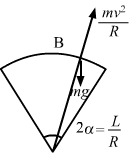
Suppose it loses contact at B.
At point B, we get: mgcosθ=mv2R⇒v2=RgcosθPutting the value of v, we get:Rg22=Rgcosθ⇒Rg2=Rgcosθ⇒cosθ=12⇒ θ=60°=π3∵ θ=LR∴ L=Rθ=πR3So, it will lose contact at a distance
πR3from the highest point.
(c) Let the uniform speed on the bridge be v. The chances of losing contact is maximum at the end bridge. We have: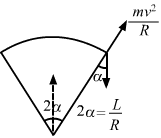
α=L2RSo,mv2R=mgcosα⇒v=gRcosL2R
Question 20:
A car goes on a horizontal circular road of radius R, the speed increasing at a constant rate
dvdt=a. The friction coefficient between the road and the tyre is μ. Find the speed at which the car will skid.
Answer:
Let v be the speed of the car.
Since the motion is non-uniform, the acceleration has both radial (ar) and tangential (at) components.
ar=v2Rat=dvdt=aResultant magnitude=v2R2+a2
From free body diagram, we have:
mN=mv2R2+a2⇒ μmg=mv2R2+a2⇒μ2g2=v4R2+a2
⇒v4R2=(μ2g2-a2)⇒v4=(μ2g2-a2)R2⇒v=[(μ2g2-a2)R2]1/4
Question 21:
A block of mass m is kept on a horizontal ruler. The friction coefficient between the ruler and the block is μ. The ruler is fixed at one end and the block is at a distance L from the fixed end. The ruler is rotated about the fixed end in the horizontal plane through the fixed end. (a) What can the maximum angular speed be for which the block does not slip? (b) If the angular speed of the ruler is uniformly increased from zero at an angular acceleration α, at what angular speed will the block slip?
Answer:
(a) Given:
Mass of the block = m
Friction coefficient between the ruler and the block = μ
Let the maximum angular speed be ω1 for which the block does not slip
Now, for the uniform circular motion in the horizontal plane, we have:
μmg=mω12L∴ω1=μgL
(b) Let the block slip at an angular speed ω2.
For the uniformly accelerated circular motion, we have:
μmg=mω22L2+mLα22⇒ω24+α2=μ2g2L2
⇒ω2=μgL2-α21/4
Question 22:
A track consists of two circular parts ABC and CDE of equal radius 100 m and joined smoothly as shown in figure. Each part subtends a right angle at its centre. A cycle weighing 100 kg together with the rider travels at a constant speed of 18 km/h on the track. (a) Find the normal contact force by the road on the cycle when it is at B and at D. (b) Find the force of friction exerted by the track on the tyres when the cycle is at B, C and. (c) Find the normal force between the road and the cycle just before and just after the cycle crosses C. (d) What should be the minimum friction coefficient between the road and the tyre, which will ensure that the cyclist can move with constant speed?
Figure
Answer:
Given:
Radius of the curves = r = 100 m
Mass of the cycle = m = 100 kg
Velocity = v = 18 km/hr = 5 m/s
(a) At B, we have:mg-mv2r=N⇒N=(100×10)-100×25100 =1000-25=975 NAt D, we have: N=mg+mv2r =1000+25=1025 N(b) At B and D, we have:
Tendency of the cycle to slide is zero.
So, at B and D, frictional force is zero.
At C, we have:
mgsinθ = f
⇒1000×12=707 N
(c) (i) Before C, mgcosθ-N=mv2r⇒N=mg cosθ-mv2r =707-25=682 N(ii) N-mgcosθ=mv2r⇒N=mv2r+mgcosθ =25+707=732 N(d) To find the minimum coefficient of friction, we have to consider a point where N is minimum or a point just before c .
Therefore, we have:μN=mgsinθ⇒μ×682=707⇒ μ=1.037
Question 23:
In a children’s park a heavy rod is pivoted at the centre and is made to rotate about the pivot so that the rod always remains horizontal. Two kids hold the rod near the ends and thus rotate with the rod. Let the mass of each kid be 15 kg, the distance between the points of the rod where the two kids hold it be 3.0 m and suppose that the rod rotates at the rate of 20 revolutions per minute. Find the force of friction exerted by the rod on one of the kids.
Figure
Answer:
Given:
Frequency of rod=n=20 rev per min⇒n= 2060=13rev/sTherefore, we have:
angular velocity of rod,
Angular velocity of rod=ω=2πn=2π3rad/sMass of each kid =
m=15 kgRadius =
r=32=1.5 m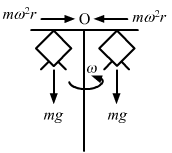
∴Frictional force=F=mrω2⇒F=15×(1.5)×(2π)29 =5×(0.5)×4π2=10π2 NThus, the force of frictional on one of the kids is 10
π2.
Question 24:
A hemispherical bowl of radius R is rotated about its axis of symmetry which is kept vertical. A small block is kept in the bowl at a position where the radius makes an angle θ with the vertical. The block rotates with the bowl without any slipping. The friction coefficient between the block and the bowl surface is μ. Find the range of the angular speed for which the block will not slip.
Answer:
When the bowl rotates at maximum angular speed, the block tends to slip upwards.
Also, the frictional force acts downward.
Here, we have:
Radius of the path that the block follow = r = Rsinθ
Let N1 be the normal reaction on the block and ω1 be the angular velocity after which the block will slip.
From the free body diagram-1, we get:
N1-mgcosθ=mω12(Rsinθ)sinθ …(i)μN1+mgsinθ=mω12(Rsinθ)cosθ …(ii) 
On solving the two equation, we get:
ω1=g(sinθ+μ cosθ)R sinθ (cosθ-μ sinθ)1/2Let us now find the minimum speed (ω2) on altering the direction of
μ(as shown in figure):
ω2=g(sinθ-μ cosθ)R sinθ (cosθ+μ sinθ)1/2
Hence, the range of speed is between ω2 and ω1.
Question 25:
A particle is projected with a speed u at an angle θ with the horizontal. Consider a small part of its path near the highest position and take it approximately to be a circular arc. What is the radius of this circular circle? This radius is called the radius of curvature of the curve at the point.
Answer:
At the highest point, the vertical component of velocity is zero.
So, at the highest point, we have:
velocity = v = ucosθ
Centripetal force on the particle =
mv2r
⇒mv2r=mu2cos2θrAt the highest point, we have:
mg=mv2rHere, r is the radius of curvature of the curve at the point.
⇒r=u2cos2θg
Question 26:
What is the radius of curvature of the parabola traced out by the projectile in the previous problem at a point where the particle velocity makes an angle θ/2 with the horizontal?
Answer:
Let u be the initial velocity and v be the velocity at the point where it makes an angle
θ2with the horizontal component.
It is given that the horizontal component remains unchanged.
Therefore, we get:
v cos θ2=u cosθ
⇒v=ucosθcosθ2 …i mgcosθ2=mv2r …ii⇒r=v2gcosθ2On substituting the value of v from equation (i), we get:
r=u2cos2θgcos2θ2
Question 27:
A block of mass m moves on a horizontal circle against the wall of a cylindrical room of radius R. The floor of the room on which the block moves is smooth but the friction coefficient between the wall and the block is μ. The block is given an initial speed v0. As a function of the speed v write (a) the normal force by the wall on the block, (b) the frictional force by wall and (c) the tangential acceleration of the block. (d) Integrate the tangential acceleration
dvdt=vdvdsto obtain the speed of the block after one revolution.
Answer:

Given:
Radius of the room = R
Mass of the block = m
(a) Normal reaction by the wall on the block = N =
mv2R(b) Force of frictional by the wall =
μN=μmv2R(c) Let at be the tangential acceleration of the block.
From figure, we get:
-μmv2R=mat⇒at=-μv2R(d)
On using a=dvdt=vdvds, we get:vdvds=μv2 R⇒ds=-RμdvvIntegrating both side, we get:s=-RμInv+cAt, s=0, v=v0So, c=RμInv0⇒s=-RμInvv0⇒ vv0=e-μsR⇒v=v0e-μsRFor one rotation, we have:s=2πr∴ v=v0e-2πμ
Page No 116:
Question 28:
A table with smooth horizontal surface is fixed in a cabin that rotates with a uniform angular velocity ω in a circular path of radius R. A smooth groove AB of length L(<<R) is made the surface of the table. The groove makes an angle θ with the radius OA of the circle in which the cabin rotates. A small particle is kept at the point A in the groove and is released to move at the point A in the groove and is released to move along AB. Find the time taken by the particle to reach the point B.
Figure
Answer:
Let the mass of the particle be m.
Radius of the path = R
Angular velocity = ω
Force experienced by the particle = mω2R
The component of force mRω2 along the line AB (making an angle with the radius) provides the necessary force to the particle to move along AB.
∴mω2R cosθ=ma⇒a=ω2RcosθLet the time taken by the particle to reach the point B be t.
On using equation of motion, we get:L=ut+12at2⇒L=12ω2Rcosθt2⇒t2=2Lω2Rcosθ⇒t=2Lω2Rcosθ
Question 29:
A car moving at a speed of 36 km/hr is taking a turn on a circular road of radius 50 m. A small wooden plate is kept on the seat with its plane perpendicular to the radius of the circular road. A small block of mass 100 g is kept on the seat which rests against the plate. the friction coefficient between the block and the plate is .(a) Find the normal contact force exerted by the plate on the block. (b) The plate is slowly turned so that the angle between the normal to the plate and the radius of the road slowly increases. Find the angle at which the block will just start sliding on the plate.
Figure
Answer:
Given:
Speed of the car = v = 36 km/h = 10 m/s
Radius of the road = r = 50 m
Friction coefficient between the block and the plate = μ = 0.58
Mass of the small body = m = 100 g = 0.1 kg
(a) Let us find the normal contact force (N) exerted by the plant of the block.
N=mv2r=0.1×10050=15=0.2(b) The plate is turned; so, the angle between the normal to the plate and the radius of the rod slowly increases.
Therefore, we have:
N=mv2rcosθ …iμN=mv2rsinθ …(ii)On using i and ii, we get:μmv2rcosθ =mv2rsinθ⇒μ=tanθ⇒θ=tan-1 (0.58)≈30°
Question 30:
A table with smooth horizontal surface is placed in a circle of a large radius R. A smooth pulley of small radius is fastened to the table. Two masses m and 2m placed on the table are connected through a string going over the pulley. Initially the masses are held by a person with the string along the outward radius and then the system is released from rest (with respect to the cabin). Find the magnitude of the initial acceleration of the masses as seen from the cabin and the tension in the string.
Figure
Answer:
Let the bigger mass accelerates towards left with acceleration a.
Let T be the tension in the string and ω be the angular velocity of the table.
From the free body diagram, we have:
T-ma-mω2R=0 …(i)T+2ma-2mω2R=0 …(ii)On subtracting eq. (i) by eq. (ii), we get:3ma=mω2R⇒a=ω2R3Substituting the value of a in eq. (i), we get:
T=mω2R3+mω2R⇒T=43mω2R
Chapterwise HC Verma Solutions Class 11 Physics :
- Chapter 1 – Introduction to Physics
- Chapter 2 – Physics and Mathematics
- Chapter 3 – Rest and Motion: Kinematics
- Chapter 4 – The Forces
- Chapter 5 – Newton’s Laws of Motion
- Chapter 6 – Friction
- Chapter 7 – Circular Motion
- Chapter 8 – Work and Energy
- Chapter 9 – Center of Mass, Linear Momentum, Collision
- Chapter 10 – Rotational Mechanics
- Chapter 11 – Gravitation
- Chapter 12 – Simple Harmonic Motion
- Chapter 13 – Fluid Mechanics
- Chapter 14 – Some Mechanical Properties of Matter
- Chapter 15 – Wave Motion and Wave on a String
- Chapter 16 – Sound Wave
- Chapter 17 – Light Waves
- Chapter 18 – Geometrical Optics
- Chapter 19 – Optical Instruments
- Chapter 20 – Dispersion and Spectra
- Chapter 21 – Speed of Light
- Chapter 22 – Photometry
About the Author – HC Verma
HC Verma, the author of many popular and well-renowned Physics books, was born on 8 April 1952. Passing out from one of the most prestigious colleges of the country, IIT Kanpur, he worked as an experimental physicist in the Department of Nuclear Physics.
His most famous works which he is known for include the two-volume Concepts of Physics. He also worked for the social upliftment of the economically weaker children through his organization named Shiksha Sopan. He is also the recipient of the Padma Shri, which is considered India’s fourth-highest civilian award. He received the same because of his contribution and valuable work in the field of Physics.
